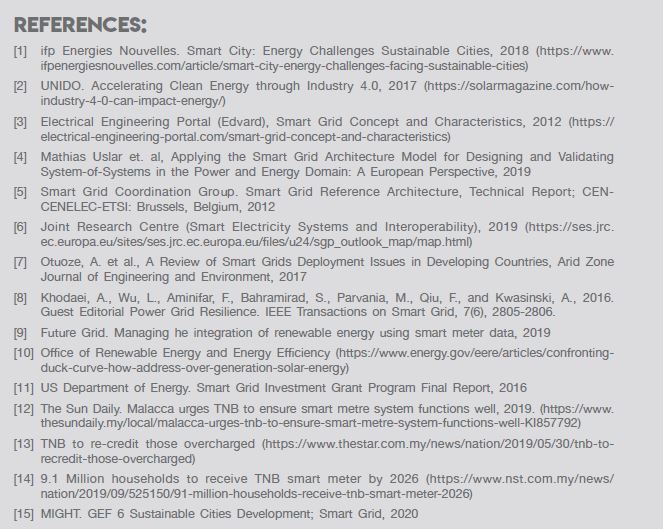by | Mohamad Azreen Firdaus Abd Aziz, azreen@might.org.my | Ir. Mohd Qaharuddim Abdullah, qaharuddin@might.org.my | Ahmad Hafizi Mohamed @ Adam, hafizi@might.org.my | Mohd Hasan Mohd Saaid, hasan@might.org.my | Nor Shahida Razali, shahidarazali@might.org.my
There are downsides to everything; there are unintended consequences to everything
– Steve Jobs
SMART GRID IN A PERFECT WORLD
The majority of countries around the world today are gearing up to become vibrant smart cities. To deliver multi-sided smart homes and facilities, most countries find themselves in a race to implement Industry 4.0. Intelligent use of energy is one of the key features of smart homes and facilities in order to cut down on our use of fossil fuels. Despite this, utility companies will have a tough call to answer in the immediate future. Soon, they will be asked to align their business strategies and solutions across government, industry, commercial and residential clients in a bid to provide sustainable energy.
Energy plays a critical role as one of the key enablers of smart city development. Yet, energy supply is tied up with population size and urbanization [1]. On the other hand, energy provides a fundamental support for sustainable operations of Industry 4.0 technologies—powering equipment, machines and facilities as described by the United Nations Industrial Development Organization (UNIDO) in a special report titled Accelerating Clean Energy through Industry 4.0 in 2017 [2].
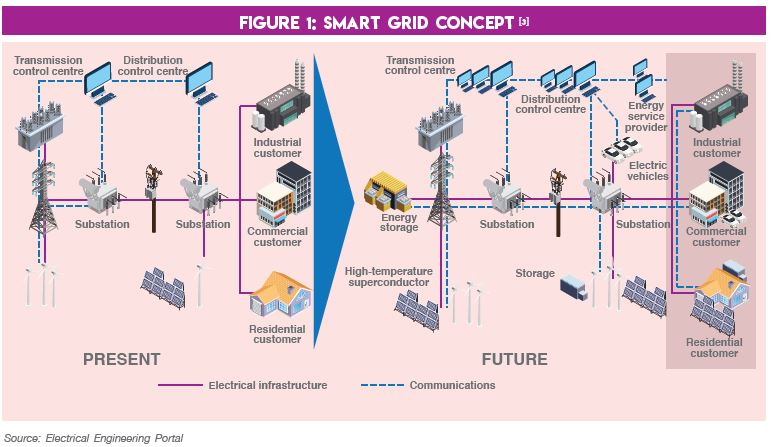
Ageing infrastructure, technical and non-technical losses, inaccurate energy forecasting are complex challenges faced by the industry. To balance the energy generation mix between renewable and conventional sources (due to the lack of integration with sustainable energy technologies), the industry can no longer defer finding a solution. Furthermore, ineffective energy management and the disparity between demand and supply are among key challenges that energy utility companies have to solve to catch up with the latest industrial growth and development trends. As a result, improving the energy supply industry and meeting rising demand are a main concern for utility companies. Supported by a new framework, the smart grid technology is a key enabler that can be adopted to address all these issues. It utilises digitally advanced technologies along the value chain of energy generation, transmission and distribution. On the consumption side, it manages the demand and supply of energy effectively [3]. Figure 1 shows one example of an integrated smart grid architecture and communication system. There are a number of state of- the-art architectures in development to complement the system in order to meet the modernisation of the energy industry [4]. Figure 2 shows an example of a smart grid architectural model which consists of multiple integration channels and features. Therefore, this bi-directional integration with renewable energy sources provides power quality that minimizes the interruption of supply. This helps utility companies provide energy to clients in a more efficient and sustainable approach.
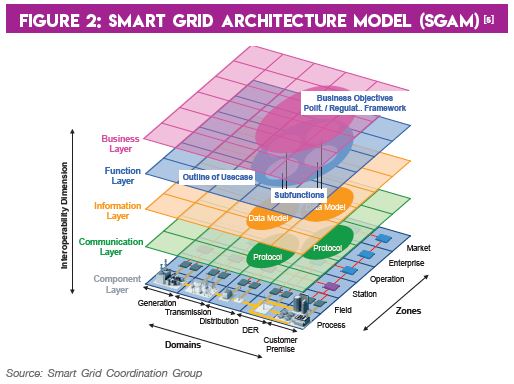
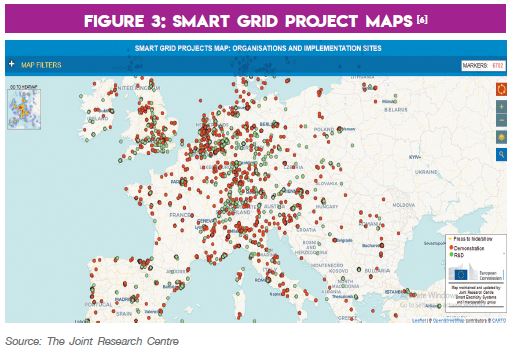 Figure 3 shows a global smart grid project map that comprises of its representation (red dots) and R&D activities (green dots) that appear to be highly concentrated in Europe.
Figure 3 shows a global smart grid project map that comprises of its representation (red dots) and R&D activities (green dots) that appear to be highly concentrated in Europe.
THE REALITIES AND CONSEQUENCES
As smart grid implementation grows, either at R&D or demonstration level, the numbers however, only represent the framework’s introducers and beneficiaries. Without any intention to be critical of anyone, this article seeks to highlight some negative consequences of the smart grid technology derived from actual case studies. On the basis of a global context, ultimately, the breakdown is intended as a lesson for Malaysian stakeholders to consider before jumping on the smart grid technology bandwagon.
>> INVESTMENT BY CUSTOMER
In African countries, smart grid implementation has become a critical issue after the continent’s national utility companies expedited the roll out process following the introduction of a programme called Credited Advanced Payment for Metering Implementation (CAPMI). This however, was a problem inflicted on consumers who faced resource limitation and were unwilling to finance the installation using their own money.
The improper process of appointing suppliers to carry out smart meter installation wreaked havoc when the process took longer than scheduled and was prone to red tape elements. This led to a counter response when African consumers started to attempt electricity theft, thus posing another stumbling block in the continent’s bid to adapt the technology [7]. Since, the rate for non-technical losses has been rapidly declining.
>> LIMITED BUDGET FOR R&D AND O&M ACTIVITIES
Smart grid investment should also be injected with investment for R&D. Many implementation issues that occur need to be rectified through R&D fixes that require a significant amount of resources. Limited budget allocation and unsystematic R&D endeavours to address on the ground issues will only cause delay to the deployment process as well as inefficient operations and maintenance works [7]. R&D, however, will only deliver real solutions if it is coupled with commercialisation (R&D&C) in order to reap the full benefits of the initial investment made.
>> CYBER-ATTACKS
Cyber-attacks are one of the major threats to smart grid facilities. Cyber-attacks may prompt the interruption of energy supply and demand. Given that smart grids highly depend on IoT, smart grid facilities are vulnerable to the crippling damages of cyber-attacks. Hence, smart grid systems must be backed and associated with well-structured cyber-security measures to be more resilient. As reported globally, the investment spent to combat cyber-crimes was around USD445 billion yearly [8]. Multi-layered cyber security protocols need to be put in place in view of the grave damages of energy disruption that cyber-attacks can impose.
>> IMBALANCE GENERATION MIX AND DUCK CURVE
Some countries are facing duck curve related issues. In utility-scale electricity generation, the duck curve is a power production graph over the course of a day that shows the timing imbalance between peak demand and renewable energy production. Higher penetration of solar PV energy and the imbalance of renewable energy injection can cause a host of problems to smart grids. This will strain utility companies’ operations as a result of having to deal with the trouble of managing voltage fluctuation and difficulty in order to keep thermal stress of assets at bay. As the system network is incapable of coping with multiple variables of load injections, it will cause consumers to experience over-voltage, which may result in inverters switching off during daytime. Another issue which may arise includes the lack of live data visibility from systems and languages from various technology providers. This set of data is crucial for utility providers to conduct further analysis and chart future service improvement. [9] As a recommended strategy, the Load Dispatch Center may need to conduct frequent load-demand forecasts and factor in other key data variables that can cater to all probable energy scenarios.
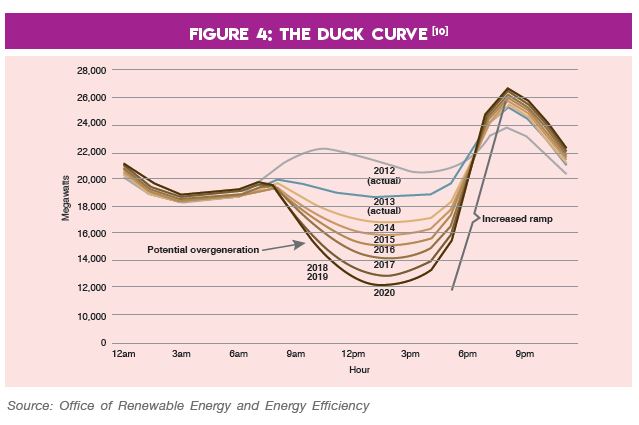
>> INVESTOR INTEREST
In some countries that involve smart grid deployment, investors will surely face issues in managing their resources. Understandably, each investor will have their own preferred areas of investment. As shown in Figure 5, European countries dominate and focus more on smart network management at 34% followed by demand management at 25%. European countries however are less focused on e-mobility and integration, with only a fraction of the total investment amount going to the development of scaling up renewable energy sources [11]. Therefore, to balance the vested investment interests and the technical capabilities of vendors, a common understanding needs to be reached around local product compatibility, foreign direct investment (FDI) and “domestic direct plus indirect investment (DI)”. All this needs to be ironed out to safeguard Malaysia’s national agenda in the context of energy security.
>> CONSUMER PERCEPTION
Malaysia has kicked off its smart grid implementation strategy with the installation of smart meters for residentials in Melaka. Done in phases, the strategy is supported by advanced metering infrastructure (AMI). However, in May 2019, the adoption of smart meters has raised one major concern by the public, urging Malaysia’s national utility company to implement the system thoroughly and allow energy consumption to be monitored with consistent and precise data generation displayed at the meter. In addition to this, sceptics argued that the installation had cost consumers higher electricity bills in comparison with the previously used system. In response, these issues were further investigated by a special task force from the national utility company together with the ministry and local authorities in a bid to resolve the concerns. The initiatives engaged consumers via a special program to disseminate information on smart meter information. Of these, clarification of meter tampering and consolidation of reports issued by the public as well as reimbursement for any overcharges and on-site smart meter inspection were also carried out [12]. As a result, a comprehensive workaround between the ministry, regulators, consumers, the communities and local authorities was concluded as a vital element in achieving a successful smart grid project deployment.
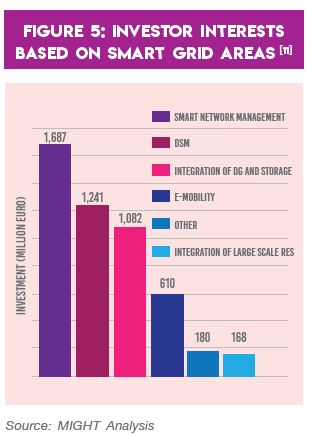
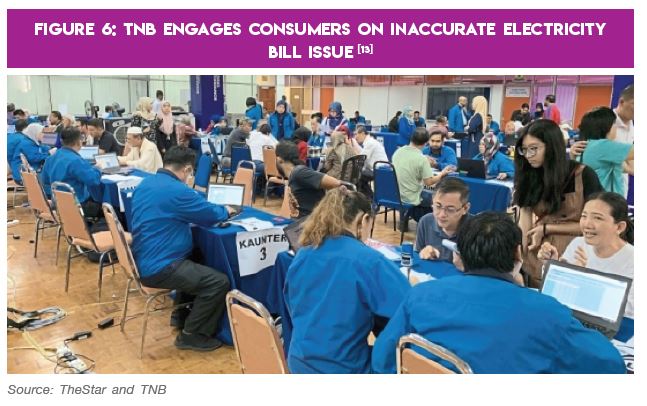
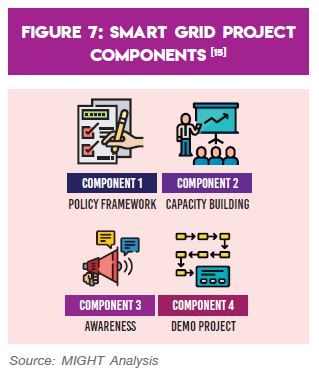
REINVIGORATING THE ENERGY INDUSTRY VIA SMART GRID FOR OUR FUTURE LANDSCAPE
As of now, there are 300,000 units of smart meters installed in Melaka. Malaysia will continue the effort progressively and the project is moving towards 1.2 million meter installations in Klang Valley this year. By 2026, it is expected that 9.1 million Malaysian households will be equipped with Tenaga Nasional Berhad (TNB) smart meters in peninsular Malaysia [14].
In part, MIGHT is leading an advanced role to further the high tech industry’s development. MIGHT is also overseeing the implementation of a holistic smart grid approach in Malaysia under the development wing of Global Environmental Facility (GEF) 6 of Sustainable Cities Development under UNIDO which consists of four key components including policy framework, capacity and awareness building programmes and project demonstration. This project will be mobilised in a collaboration with stakeholders namely Energy Commission, TNB Research (TNBR) Sdn Bhd, UNITEN and Perbadanan Teknologi Hijau Melaka.
Most importantly, lessons learnt from other countries should be taken into consideration and leveraged to Malaysia’s advantage in accelerating smart grid development. This goes to ensure that Malaysia is well prepared with hindsight in relation to some of the unintended consequences that occurred previously across other parts of the world. Meanwhile, onto the project’s aspiration, the due diligence will certainly provide added values to the on-going high-tech project development. MIGHT, together with its partners, believe that there is a need to provide comprehensive awareness for the public on smart grid implementation. In turn, this will promote a soft landing for the project’s acceptance by the public. Also, policy deliberation that affects public opinions needs to be emphasised and adequately addressed. By building alignment with all related stakeholders, this will contribute to better policy instruments and boost the project’s implementation timeline. Advocacy of the smart grid development too needs to be ramped up nation-wide to make sure a successful deployment formula is repeatable for other states and cities to follow.
In addition, capacity building will nurture Malaysia’s local talents. In a sense, managing various technology components in smart grid development and demonstration will provide a baseline understanding in the integration of various sustainable energy technologies. In the demand and supply equation, how these new technologies can be seamlessly integrated with existing conventional energy generation plants have to be a tenable proposition understood by all. At the end of the day, concerted efforts that spanned policy framework, capacity and awareness building as well as project demonstration in Melaka will provide breakthrough inputs for Malaysia’s national utility company, TNB. Effective smart grid project deployment and energy management are the way of the future to achieve sustainable energy as demanded by Sustainable Development Goal (SDG) 7 in ensuring access to affordable, reliable, sustainable and modern energy for all. Ultimately, the smart grid concept supports Malaysia’s national renewable energy aspiration. This bodes well with the national 20% target of renewable energy mix in the country’s energy generation by 2025.
